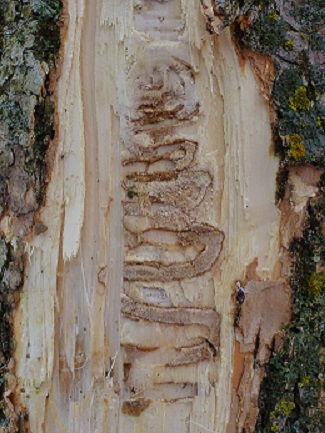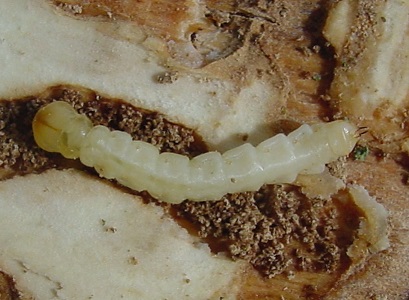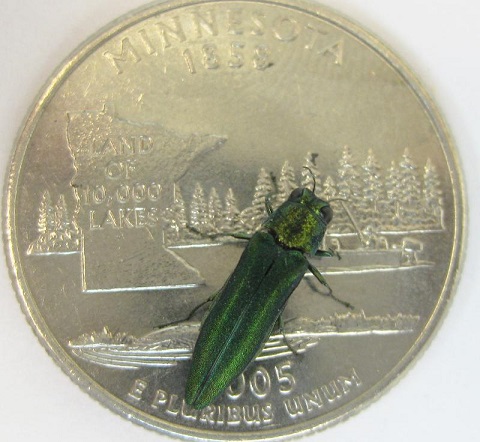In Minnesota, EAB completes one generation every 1 to 2 years. Eggs are laid from mid-June through August. Female EAB deposit their eggs individually on ash trees between layers of outer bark in cracks and crevices of the branches and trunk of the tree. The eggs typically hatch within two weeks, depending on temperature. Ash trees are killed by the tunneling of EAB larvae under the tree's bark.
For a better understanding of the EAB life cycle, watch the video Cycle of Destruction.
Emerald ash borer flight season begins May 1st
Minnesota Department of Agriculture considers May 1st - September 30th to be the flight season for EAB. This means that EAB adult beetles are emerging from infested trees or wood and flying in search of new hosts during this time. Emerald ash borer larvae complete their development by pupating into adult beetles in the spring and early summer. However, this process only occurs when temperatures are sufficiently warm and requires a certain amount of accumulated heat - i.e., development time. Accumulated heat can be measured and tracked using degree day models, which measures time spent above a specific temperature threshold.
For EAB, a base temperature of 50º F is used. The following are estimated thresholds of EAB development and activity:
- 450 degree days = First EAB adults begin to emerge
- 900-1100 degree days = Peak EAB adult activity
- Current base 50º F degree day accumulations for Minnesota are available from the US degree-day mapping calculator.
Identification
- Adults are small, metallic green wood boring beetles about 3/8 to 1/2 inch long and 1/8 inch wide.
- Emerald ash borer larvae are cream-colored, with bell-shaped body segments. The larvae have two spine like projections at the end of their body, called urogomphi, which are a defining characteristic. Their size varies as they feed and grow beneath the ash tree's bark. The larvae create serpentine, or "S" shaped, galleries under the bark, which are a definitive sign of EAB when found in ash trees.
- Emerald ash borer eggs and pupae are not commonly seen and are difficult to identify.



There are many insects in Minnesota that can be mistaken for EAB due to their size, shape or metallic green color. Identification can be difficult if the insect is not found associated with its ash tree host. For more information, refer to the Insects Commonly Confused with EAB reference sheet.
In Minnesota, EAB completes one generation every 1 to 2 years. Eggs are laid from mid-June through August. Female EAB deposit their eggs individually on ash trees between layers of outer bark in cracks and crevices of the branches and trunk of the tree. The eggs typically hatch within two weeks, depending on temperature. Ash trees are killed by the tunneling of EAB larvae under the tree's bark.
For a better understanding of the EAB life cycle, watch the video Cycle of Destruction.
Emerald ash borer flight season begins May 1st
Minnesota Department of Agriculture considers May 1st - September 30th to be the flight season for EAB. This means that EAB adult beetles are emerging from infested trees or wood and flying in search of new hosts during this time. Emerald ash borer larvae complete their development by pupating into adult beetles in the spring and early summer. However, this process only occurs when temperatures are sufficiently warm and requires a certain amount of accumulated heat - i.e., development time. Accumulated heat can be measured and tracked using degree day models, which measures time spent above a specific temperature threshold.
For EAB, a base temperature of 50º F is used. The following are estimated thresholds of EAB development and activity:
- 450 degree days = First EAB adults begin to emerge
- 900-1100 degree days = Peak EAB adult activity
- Current base 50º F degree day accumulations for Minnesota are available from the US degree-day mapping calculator.
Identification
- Adults are small, metallic green wood boring beetles about 3/8 to 1/2 inch long and 1/8 inch wide.
- Emerald ash borer larvae are cream-colored, with bell-shaped body segments. The larvae have two spine like projections at the end of their body, called urogomphi, which are a defining characteristic. Their size varies as they feed and grow beneath the ash tree's bark. The larvae create serpentine, or "S" shaped, galleries under the bark, which are a definitive sign of EAB when found in ash trees.
- Emerald ash borer eggs and pupae are not commonly seen and are difficult to identify.



There are many insects in Minnesota that can be mistaken for EAB due to their size, shape or metallic green color. Identification can be difficult if the insect is not found associated with its ash tree host. For more information, refer to the Insects Commonly Confused with EAB reference sheet.
In Minnesota, EAB completes one generation every 1 to 2 years. Eggs are laid from mid-June through August. Female EAB deposit their eggs individually on ash trees between layers of outer bark in cracks and crevices of the branches and trunk of the tree. The eggs typically hatch within two weeks, depending on temperature. Ash trees are killed by the tunneling of EAB larvae under the tree's bark.
For a better understanding of the EAB life cycle, watch the video Cycle of Destruction.
Emerald ash borer flight season begins May 1st
Minnesota Department of Agriculture considers May 1st - September 30th to be the flight season for EAB. This means that EAB adult beetles are emerging from infested trees or wood and flying in search of new hosts during this time. Emerald ash borer larvae complete their development by pupating into adult beetles in the spring and early summer. However, this process only occurs when temperatures are sufficiently warm and requires a certain amount of accumulated heat - i.e., development time. Accumulated heat can be measured and tracked using degree day models, which measures time spent above a specific temperature threshold.
For EAB, a base temperature of 50º F is used. The following are estimated thresholds of EAB development and activity:
- 450 degree days = First EAB adults begin to emerge
- 900-1100 degree days = Peak EAB adult activity
- Current base 50º F degree day accumulations for Minnesota are available from the US degree-day mapping calculator.
Identification
- Adults are small, metallic green wood boring beetles about 3/8 to 1/2 inch long and 1/8 inch wide.
- Emerald ash borer larvae are cream-colored, with bell-shaped body segments. The larvae have two spine like projections at the end of their body, called urogomphi, which are a defining characteristic. Their size varies as they feed and grow beneath the ash tree's bark. The larvae create serpentine, or "S" shaped, galleries under the bark, which are a definitive sign of EAB when found in ash trees.
- Emerald ash borer eggs and pupae are not commonly seen and are difficult to identify.



There are many insects in Minnesota that can be mistaken for EAB due to their size, shape or metallic green color. Identification can be difficult if the insect is not found associated with its ash tree host. For more information, refer to the Insects Commonly Confused with EAB reference sheet.
Regulatory Status: Regulated
Emerald ash borer is regulated at the state level. All ash material and hardwood firewood is prohibited from entering Minnesota from other states without proper certification. Refer to MDA's EAB Status Map for state quarantine boundaries.

